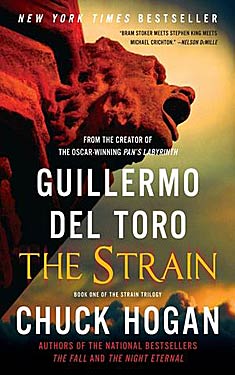The Strain, by Del Toro and Hogan
 Every vampire story writer wants to make the genre his own, for good or ill. There seems to be an unspoken competition as to who can come up with the most interesting “rules” for the nature of vampires, particularly their strengths and weaknesses. Often this just gets silly (sparkles, anyone?), but occasionally it gets fascinating, and the choices an author makes sometimes has a deeper philosophy at its root. Why else would so many post-religious authors make a point of laughing at characters who think that vampires will be afraid of crosses? Why else would some writers re-imagine vampirism as a biological plague instead of a more spiritual threat? The authors of The Strain make both these changes, and also re-think the bodily structure of the vampire while they’re at it. No longer a long-fanged pretty boy with mesmerizing eyes, the vampire here drinks its victim’s blood through a sucker in its overgrown tongue and spreads its curse through virus-like worms.
Every vampire story writer wants to make the genre his own, for good or ill. There seems to be an unspoken competition as to who can come up with the most interesting “rules” for the nature of vampires, particularly their strengths and weaknesses. Often this just gets silly (sparkles, anyone?), but occasionally it gets fascinating, and the choices an author makes sometimes has a deeper philosophy at its root. Why else would so many post-religious authors make a point of laughing at characters who think that vampires will be afraid of crosses? Why else would some writers re-imagine vampirism as a biological plague instead of a more spiritual threat? The authors of The Strain make both these changes, and also re-think the bodily structure of the vampire while they’re at it. No longer a long-fanged pretty boy with mesmerizing eyes, the vampire here drinks its victim’s blood through a sucker in its overgrown tongue and spreads its curse through virus-like worms.
This is film director Guillermo del Toro’s first novel, though not professional novelist Chuck Hogan’s first by a long shot. It’s not entirely clear which co-author took what responsibilities when writing this story, but my suspicion is that del Toro wrote the outline while Hogan wrote the prose. Based on this assumption, I have to place the blame for many of The Strain‘s rough patches on Hogan. Too many times Hogan showcases the research he put into this novel in excruciating detail. While the CDC workers vest themselves in preparation for exploring the dead airplane which sets off this unfortunate chain of events, the prose describes every single part of their containment suit in the most boorish of details. Later during an eclipse, the prose is sure to remind us that a solar eclipse is more properly termed an “occultation,” and proceeds to explain how odd it is that the sun’s corona is much hotter than its surface. None of this really matters to the story, and it feels like filler to keep the reader from noticing how thin the plot is.



















 Full Details
Full Details

